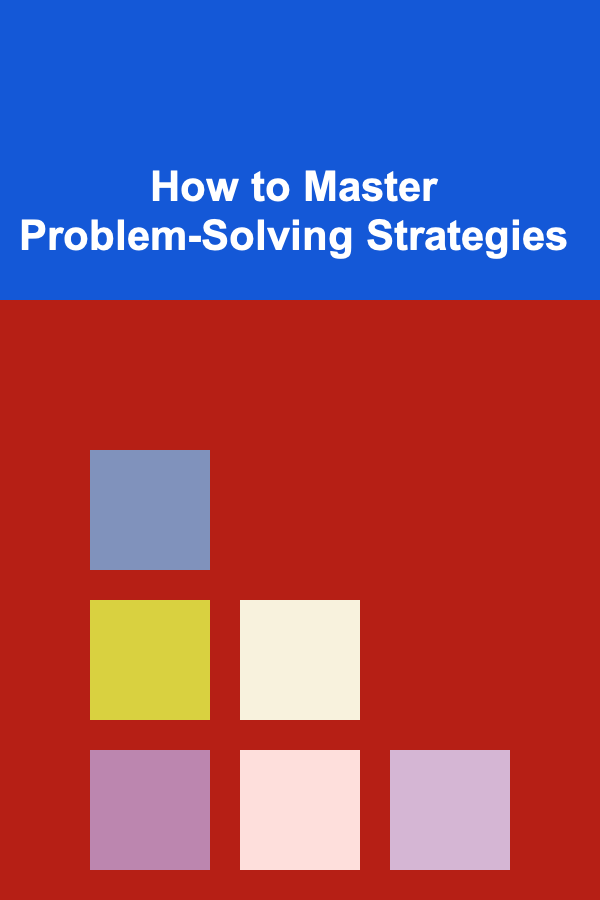
Software Architect's Toolkit: Essential Tools and Techniques for Creating Robust Systems
ebook include PDF & Audio bundle (Micro Guide)
$12.99$11.99
Limited Time Offer! Order within the next:

In today's rapidly evolving software landscape, building systems that are not only scalable but also robust is a necessity. A robust system can handle the unexpected---be it a sudden surge in user activity, hardware failures, or software bugs---without compromising performance or functionality. As a software architect, your role is to design and implement solutions that fulfill both immediate business needs and anticipate future growth.
This guide explores the essential tools, techniques, and methodologies that software architects need to build robust systems. From design patterns to specific tools and strategies, we'll dive deep into the essential components of an architect's toolkit.
Foundational Principles for Robust Systems
Before diving into specific tools, let's establish the foundational principles that guide any robust system design:
- Scalability: A robust system must be able to handle increasing loads seamlessly. The design should accommodate both horizontal scaling (adding more servers) and vertical scaling (upgrading existing hardware).
- Fault Tolerance: Robust systems anticipate failure. Components should degrade gracefully, continuing to function even when some part of the system fails.
- Maintainability: The system must be easy to maintain and extend. As new features are added, the system must remain simple and clear, avoiding unnecessary complexity.
- Performance: Ensuring the system can handle a large volume of operations while keeping response times within acceptable limits.
- Security: No matter how robust a system is in terms of availability, it's useless if it's vulnerable to attacks. Security should be designed in from the outset, not bolted on later.
Key Tools and Technologies in the Architect's Toolkit
2.1 Version Control and Collaboration Tools
Git and GitHub/GitLab/Bitbucket are indispensable tools for any modern software development project. They allow teams to track changes in code, collaborate across teams, and provide a history of system evolution.
- Git: The version control system that helps developers track, manage, and merge changes to the codebase.
- GitHub/GitLab/Bitbucket: These platforms provide a collaborative environment, including features like pull requests, code reviews, issue tracking, and CI/CD pipelines.
These tools are essential not only for collaboration but also for ensuring consistency in development workflows. Integrating a continuous integration/continuous deployment (CI/CD) pipeline into the workflow ensures that every change is automatically tested, reducing the chances of errors making it into production.
2.2 Cloud Platforms and Containerization
Cloud platforms such as Amazon Web Services (AWS) , Google Cloud Platform (GCP) , and Microsoft Azure have revolutionized how we approach scalability and availability. These platforms offer a wide array of services that enable you to build distributed systems that are both scalable and cost-efficient.
- Compute Services: EC2 (AWS), GCE (GCP), and Azure VMs provide on-demand computing resources, ensuring that you can scale up or down quickly based on load.
- Storage Services: AWS S3, Azure Blob Storage, and Google Cloud Storage provide distributed and fault-tolerant storage solutions.
- Managed Databases: These cloud services offer fully managed database solutions, reducing the operational burden of handling database scaling, backups, and maintenance.
Containerization , particularly with Docker, allows software architects to package applications into portable containers. This makes it easier to develop, test, and deploy applications in a consistent environment across various platforms.
- Docker: Ensures that applications run consistently across various environments, making it easier to scale and manage services.
- Kubernetes: Used for orchestrating and managing containerized applications, Kubernetes automates deployment, scaling, and operations of application containers across clusters of hosts.
Together, these tools enable architects to design highly available and fault-tolerant systems that can scale easily with minimal manual intervention.
2.3 Distributed Systems and Microservices
In a modern software architecture, particularly for large-scale applications, adopting a microservices architecture is often a natural choice. Microservices break down an application into smaller, self-contained services, each responsible for a distinct part of the overall functionality.
- API Gateway : Tools like Kong or Amazon API Gateway allow for managing, monitoring, and securing traffic to microservices.
- Service Mesh : Istio and Linkerd are service meshes that manage service-to-service communication, ensuring secure, reliable communication between microservices in a distributed environment.
- Message Queues and Event Streams : For reliable communication between microservices, Kafka , RabbitMQ , or Amazon SQS offer asynchronous messaging systems that enable services to communicate without being tightly coupled.
Distributed systems rely heavily on event-driven architecture, where services respond to events rather than waiting for synchronous requests. This improves resilience by decoupling services and allows the system to scale more easily under load.
2.4 Databases and Data Management
A robust system often involves managing large volumes of data. The choice of database and data architecture directly impacts performance, scalability, and fault tolerance.
- Relational Databases : Systems like PostgreSQL and MySQL are often preferred for structured data that requires complex queries and ACID (Atomicity, Consistency, Isolation, Durability) transactions.
- NoSQL Databases : MongoDB , Cassandra , and CouchDB are used when the data is unstructured or semi-structured. They are optimized for scalability and distributed architectures, making them a good fit for modern cloud applications.
- NewSQL : For scenarios where relational consistency is needed in distributed systems, CockroachDB and Google Spanner offer NewSQL solutions, which combine the benefits of NoSQL and SQL.
Sharding and Replication are two critical techniques used in managing database scalability. Sharding divides the data across multiple machines, while replication ensures data availability by duplicating it across several nodes.
2.5 Monitoring, Logging, and Observability
A system is only as robust as its ability to detect and respond to failures in real-time. Monitoring and logging are essential for providing insight into system behavior and health.
- Prometheus: A powerful open-source monitoring system and time-series database that allows for real-time metrics collection and alerting.
- Grafana: A data visualization tool that integrates with Prometheus and provides rich dashboards for monitoring system performance.
- Elasticsearch, Logstash, and Kibana (ELK Stack): ELK is an open-source set of tools used for aggregating, searching, and visualizing logs from various system components.
By using distributed tracing tools like Jaeger or Zipkin, architects can trace requests as they propagate through different microservices, making it easier to identify bottlenecks and performance issues.
2.6 CI/CD and Testing Tools
Ensuring that your codebase is continually tested and deployed to production without introducing errors is key to building a robust system. A CI/CD pipeline automates the process of testing, building, and deploying applications.
- Jenkins , CircleCI , GitLab CI: Popular tools for automating the testing and deployment of code.
- Selenium: For automating web application testing to ensure that front-end changes don't break functionality.
- JUnit , Mockito: For unit testing in Java-based applications, ensuring that logic is correct before deployment.
- Postman: A tool for API testing that allows you to automate and test RESTful APIs.
By integrating testing directly into the CI/CD pipeline, you ensure that each code change undergoes automated unit tests, integration tests, and performance tests before reaching production.
Design Patterns and Architectural Styles
Design patterns provide reusable solutions to common problems in software architecture. Some of the most important design patterns for building robust systems include:
- Layered Architecture: Separates the system into different layers (presentation, business logic, data access) to increase modularity and maintainability.
- Microservices: As mentioned earlier, this style divides the application into loosely coupled, independently deployable services, each handling a specific domain of the application.
- Event-Driven Architecture: Useful for decoupling components and ensuring that services react to events asynchronously.
- CQRS (Command Query Responsibility Segregation): Separates the read and write operations in the system, allowing for more efficient and scalable data models.
Security and Compliance
Security is paramount in designing robust systems. The following tools and practices help architects implement security measures effectively:
- OAuth 2.0 and OpenID Connect: Used for secure, token-based authentication and authorization, often in distributed systems.
- TLS (Transport Layer Security): Ensures encrypted communication between services, securing data in transit.
- OWASP: Provides best practices and tools for securing web applications, ensuring that common vulnerabilities (like SQL injection, cross-site scripting) are mitigated.
- Vulnerability Scanning : Tools like Snyk and Dependabot help identify and address security vulnerabilities in dependencies.
Conclusion
The architect's toolkit is vast, and the tools and techniques mentioned above are just the starting point for designing robust systems. By leveraging cloud platforms, containerization, microservices, distributed databases, and real-time monitoring, software architects can create systems that are resilient, scalable, and easy to maintain.
The key to success lies in selecting the right tools based on the specific requirements of the project, being proactive in addressing potential risks, and constantly evolving as technologies and best practices evolve. Robust systems are the result of thoughtful design, careful planning, and the ability to adapt to an ever-changing landscape.

How to Declutter Your Home Using the KonMari Method
Read More
How to Organize Your Home Renovation Project for Success
Read More
How to Sell Homemade Bath Bombs on Etsy: A Comprehensive Guide
Read More
How to Use Checklists to Stay on Track with Assignments
Read More
How to Use Free Design Resources Wisely
Read More
How to Master Problem-Solving Strategies
Read MoreOther Products

How to Declutter Your Home Using the KonMari Method
Read More
How to Organize Your Home Renovation Project for Success
Read More
How to Sell Homemade Bath Bombs on Etsy: A Comprehensive Guide
Read More
How to Use Checklists to Stay on Track with Assignments
Read More
How to Use Free Design Resources Wisely
Read More